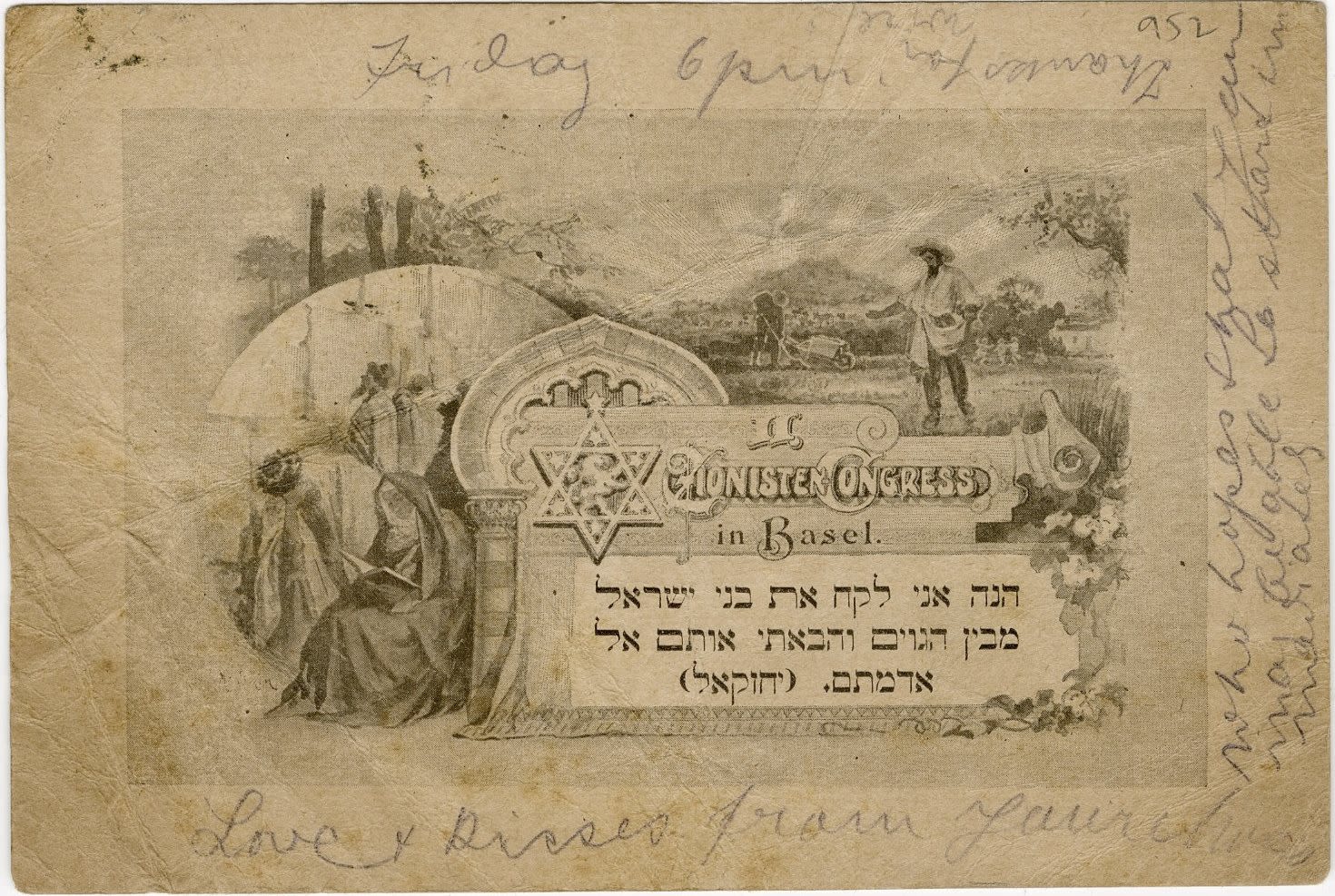
2nd Zionist Congress in Basel, Official Postcard, [1898].
Illustration of a Star of David with the seven stars of Herzl, women and men praying at the Western Wall, and on the other side peasants working the land.
Similar to the First Zionist Congress, the second was also held in the Casino Hall in Basel, where the organizational structure of the movement was based. The illustration in the postcard before us also appeared on the official axis cards of this Congress.
Rimmer Catalog, No. 3.
9X14 cm. The postcard stamped with the Congress stamp on 8/27/1898, and was sent by mail. Wrinkles and stains. Moderate - good condition.
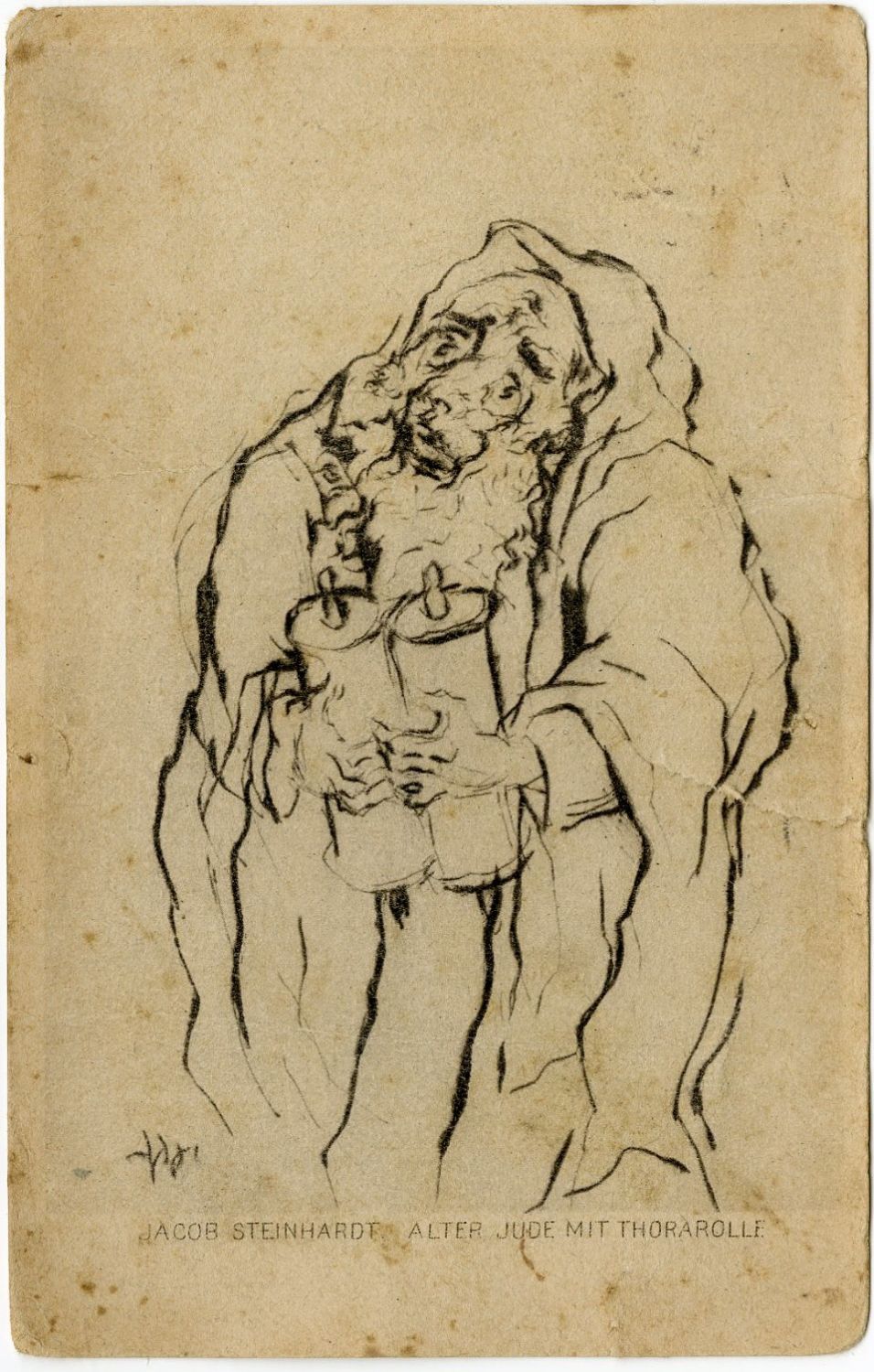
Official postcard of the Twelfth Zionist Congress held in Carlsbad 1921.
Illustration of a Jewish holding a Torah scroll by Jacob Steinhart, signed in the plate. Riemer Catalog list No. 37. On the back of the postcard is a pencil inscription dated September 9, 1921.
Tear on the right without missing - Pasted behind. Stains. moderate condition.
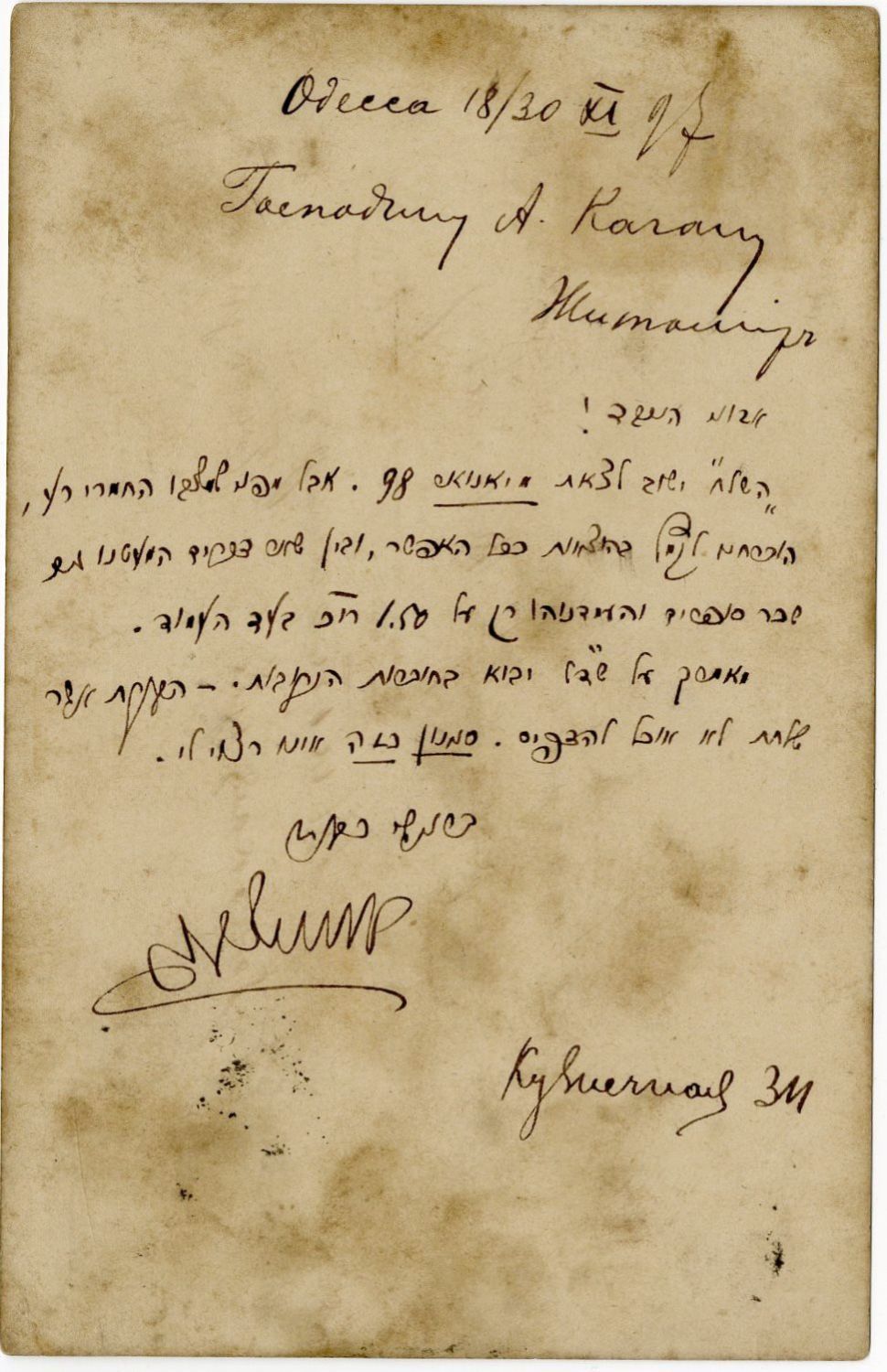
Letter in the handwriting and signature of 'Ahad Ha'am', about the 'material' condition of the 'HaShelach'. Postcard. Odessa, June 25, 1897. Hebrew.
"HaShelach will return in January 98. But because his material condition is bad, I was forced to cut back on expenses as much as possible ..." He adds that Shadal's article will be published in the journal.
In 1896, the first issue of the central and most important Hebrew periodical in the 19th and 20th Centuries 'HaShiloach', or in the accent of Ahad Ha'am the "Hashelach". Published in the framework of the company "Ahiasaf", financed by Kalonymus Ze'ev Wissotzky, the great tea manufacturer and an avid supporter of Ahad Ha'am who insisted that he be editor-in-chief of the monthly. The system was usually in Odessa or Warsaw. In the first issue of the new journal Ahad Ha'am declared: "The purpose of the journal is to know ourselves, to understand our lives and to establish our future wisely", and was attended by the best intellectuals and writers of the period. In the magazine, Ahad Ha'am expressed his Zionist approach, which advocated the training of hearts as a central goal of the national movement and to make the Land of Israel a cultural spiritual center for the Jewish people. The Shiloach published from 1896 to 1909.
[1] Undivided back Postcard. Very good condition.
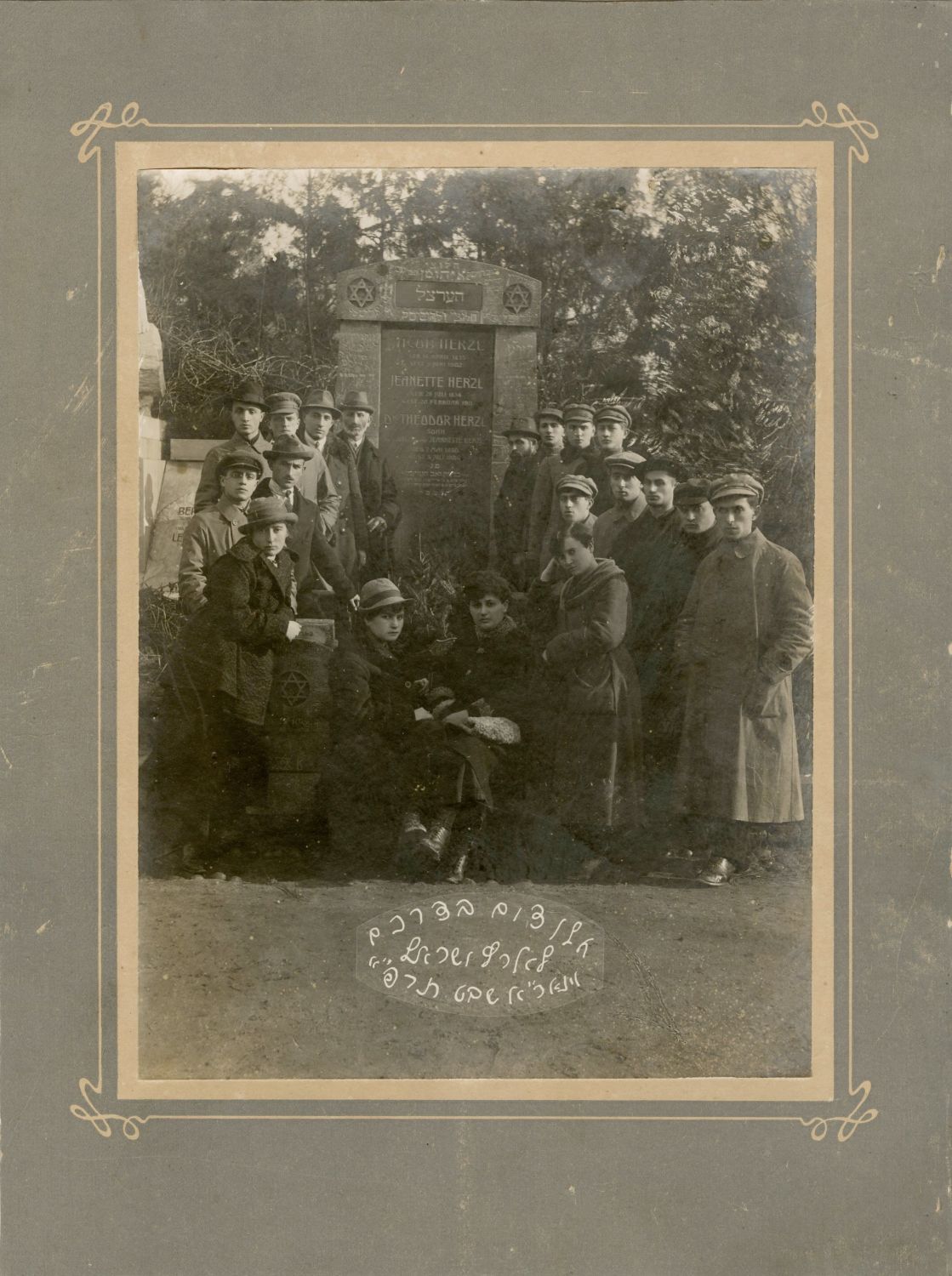
Pioneers on their way to Eretz Israel, Vienna new moon of Shvat 1921 - A large and impressive group photograph of pioneers at Herzl's tomb in Vienna.
Size: 23x17 cm. Attached to cardboard Photographer's substrate 24x32 cm. Very good condition.
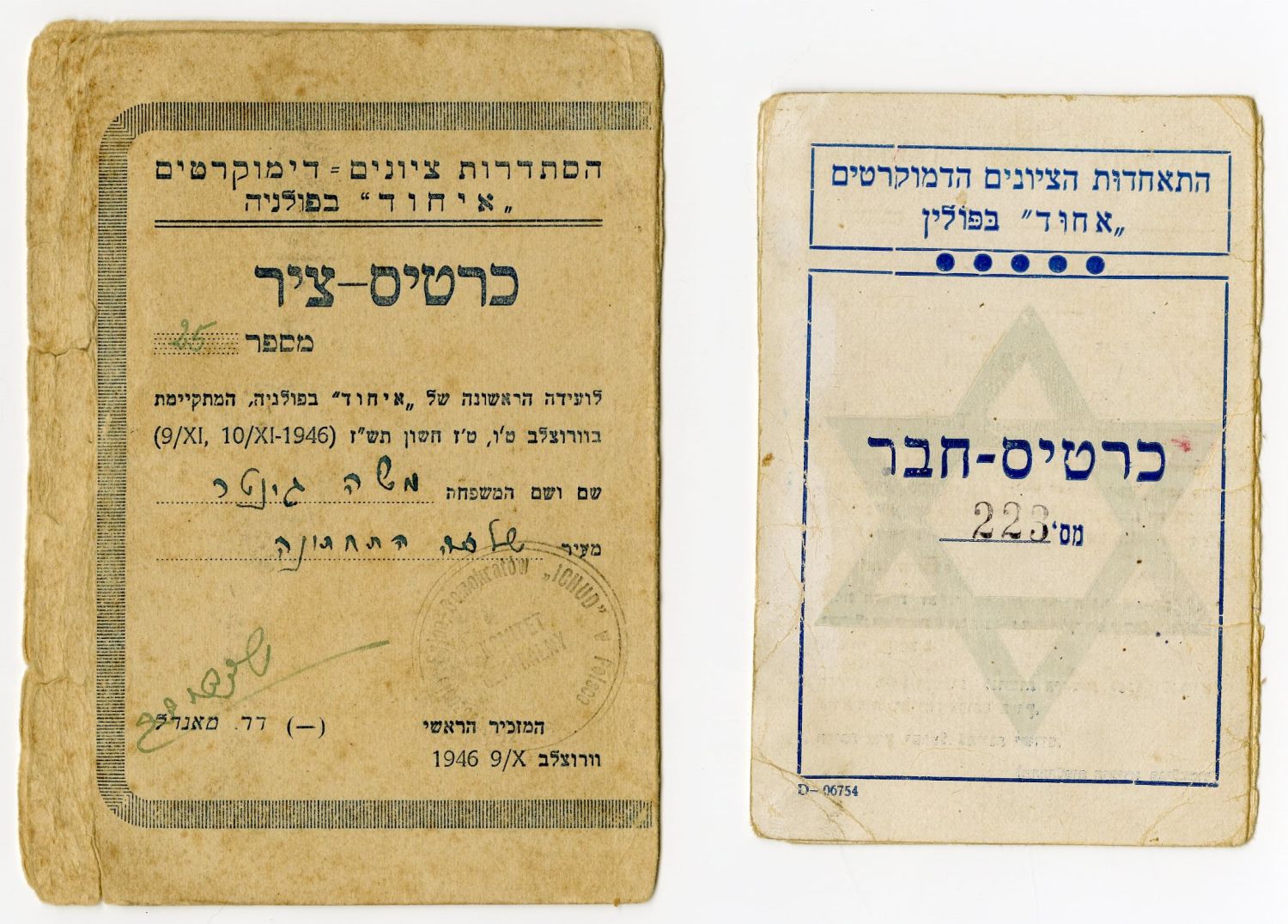
* 'Axis card for the first conference of "Ihud" in Poland, held in Wroclaw, 16, 17 Cheshvan 1946 (9/11, 10/11 - 1946), of the Axis Moshe Gunter from the city of dolnośląskie. On the card, detailed content about the first meeting, The second and third, which mainly includes discussions on the basic principles of the "Ihud". (Among other things there is a section called 'debates', and then 'continuation of debates').
* Membership card in the "Union of Democratic Zionist Associations 'Ihud' in Poland", No. 223, by David Waldman, a member of the Wroclaw movement, 9/14/1946. At the bottom of the card, under the personal details, are the principles of the movement: "Pioneering, Hebrew language and culture, immigration and protection, respect for the Hebrew tradition, respect for the opinions of a friend and opponent, cultivating the religion of work and striving for settlement."
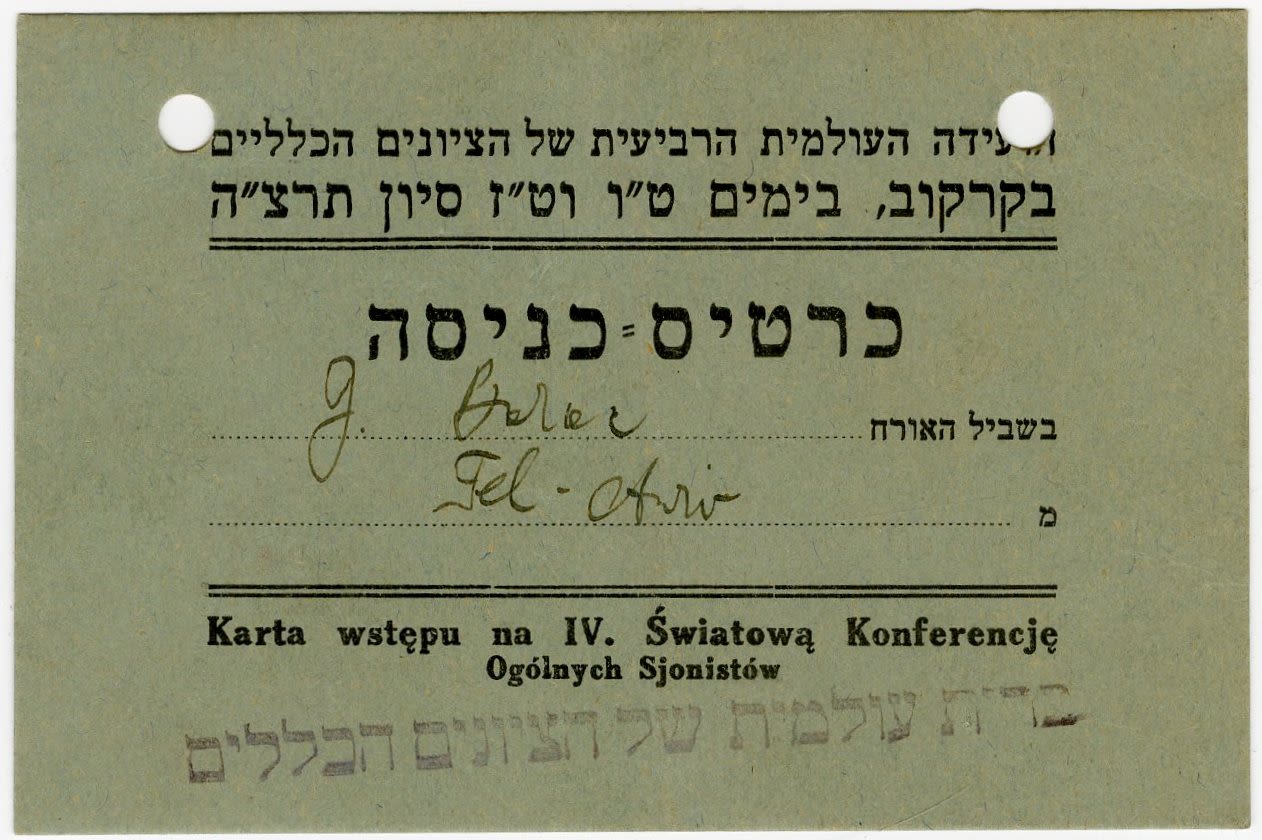
Entrance ticket to the Fourth World Conference of General Zionists in Krakow on the 15th and 16th of Sivan, 1935 - of G. Doler of Tel Aviv, signed with an ink stamp of the 'World Alliance of General Zionists'.
On the back of the card are inscriptions in Yiddish that mention the name of Shmaryahu Levin, who died that year. (Dr. Shmaryahu Levin 1867-1935) A Zionist leader, author of literature and journalism. From the leaders of the speakers at the Zionist Congresses and from the sharp opponents of the Uganda plan. One of the initiators of the establishment of the Haifa Technion and the Hebrew University of Jerusalem.
12x8 cm. Filing holes. Good condition.
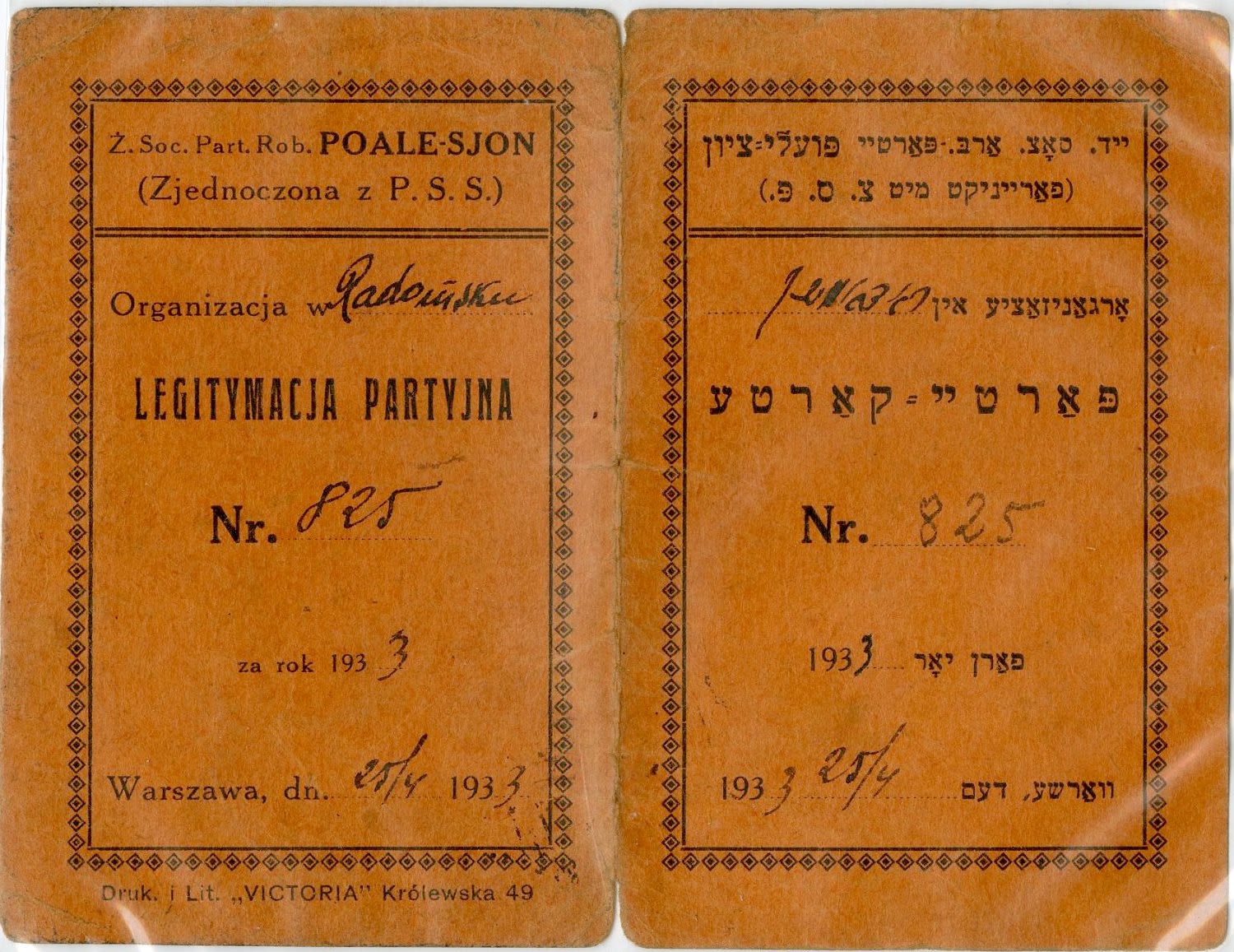
Parte karte' - participation card in the events of the Po'alei Zion organization in Radomsk, by member Avigdor Grossman, 1933. Signatures and stamps. Yiddish and Polish. The ticket allows a total of twelve entries.
14x11 cm. Very good condition.
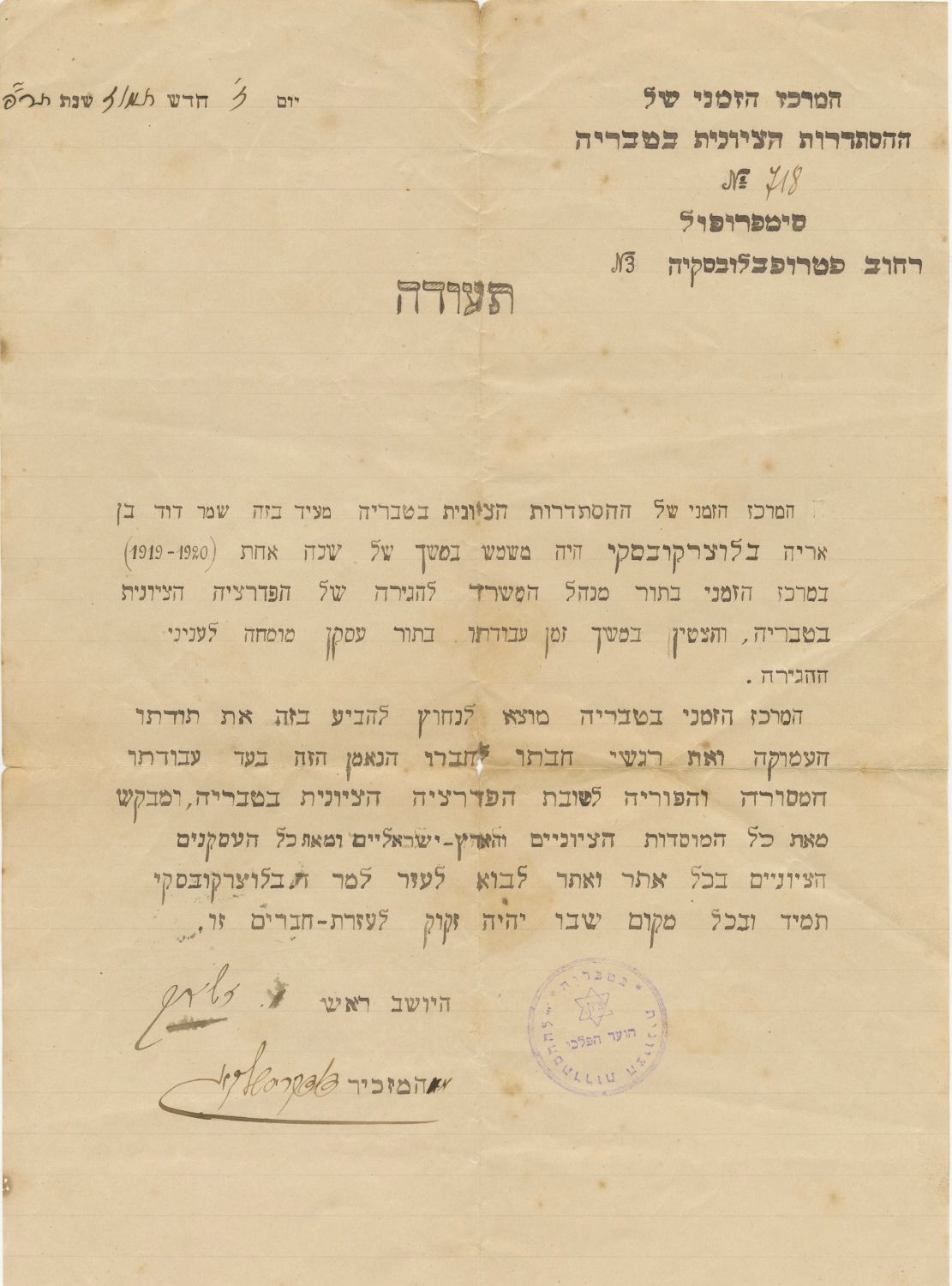
A rare 'certificate' written by a handsome 'writer' on behalf of the Temporary Center of the Zionist Organization in Tavrida - Simferopol - [Crimea] indicating that Mr. David Ben-Arie Belzerkovsky was used for one year 1919-1920 in the temporary center as director of the Federation's Immigration Office Zionist in Tavrida - Simferopol. The certificate is intended to strengthen Beltzerkowski's position vis-à-vis the Zionist institutions and the Land of Israel and vis-à-vis all Zionist activists to come by his side when he needs their help. The 'certificate' is signature by the chairman, and the secretary, and an official ink stamp of the 'district committee for the Zionist Organization in Tavrida. 7 Tammuz, 1920'.
Tiberias is a region in southern Ukraine that includes the Crimean peninsula. The province is named after the Taurus, the Greek settlers in the Crimea. Zionist documents from Simferopol in the Crimea are extremely rare, and in general the historical information about Zionist activity there is extremely poor. See, for example, the Zionist Archive, record number F30 1001.
Size: 30x22 cm. Folding marks. Few stains. Good condition.
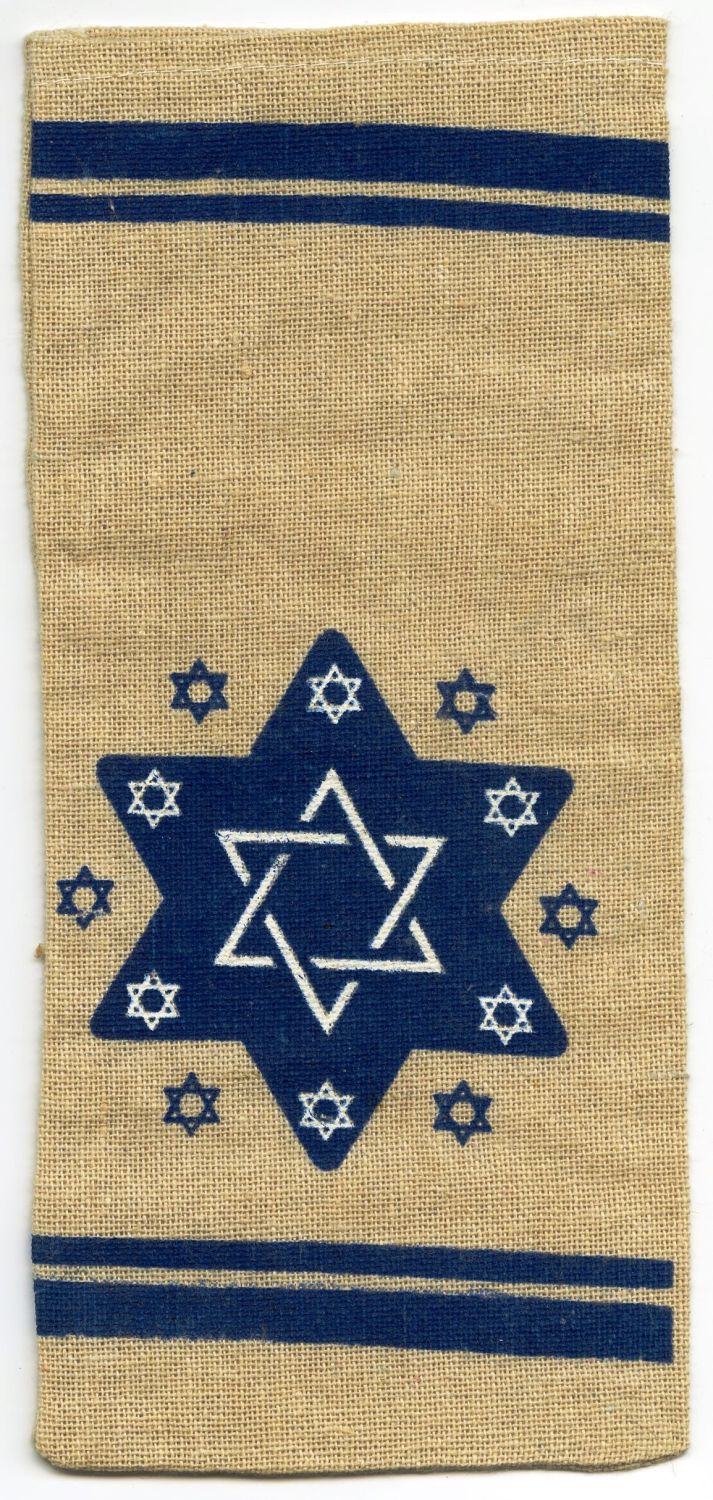
An early cloth case with the seven-star flag proposed by Herzl for the Zionist movement. The first decades of the 20th century. Very rare.
This flag shape is based on Theodor Herzl's suggestion in his book "The State of the Jews": "I imagine a white flag with seven golden stars on it. The white sheet will signal the purity of our new life. And the seven gold stars signaled our seven hours of work a day. For in the name of the work, the Jews who walk to their new land will cling".
Apparently used for a card or document related to the Zionist Congress.
22x11 cm. Good condition.
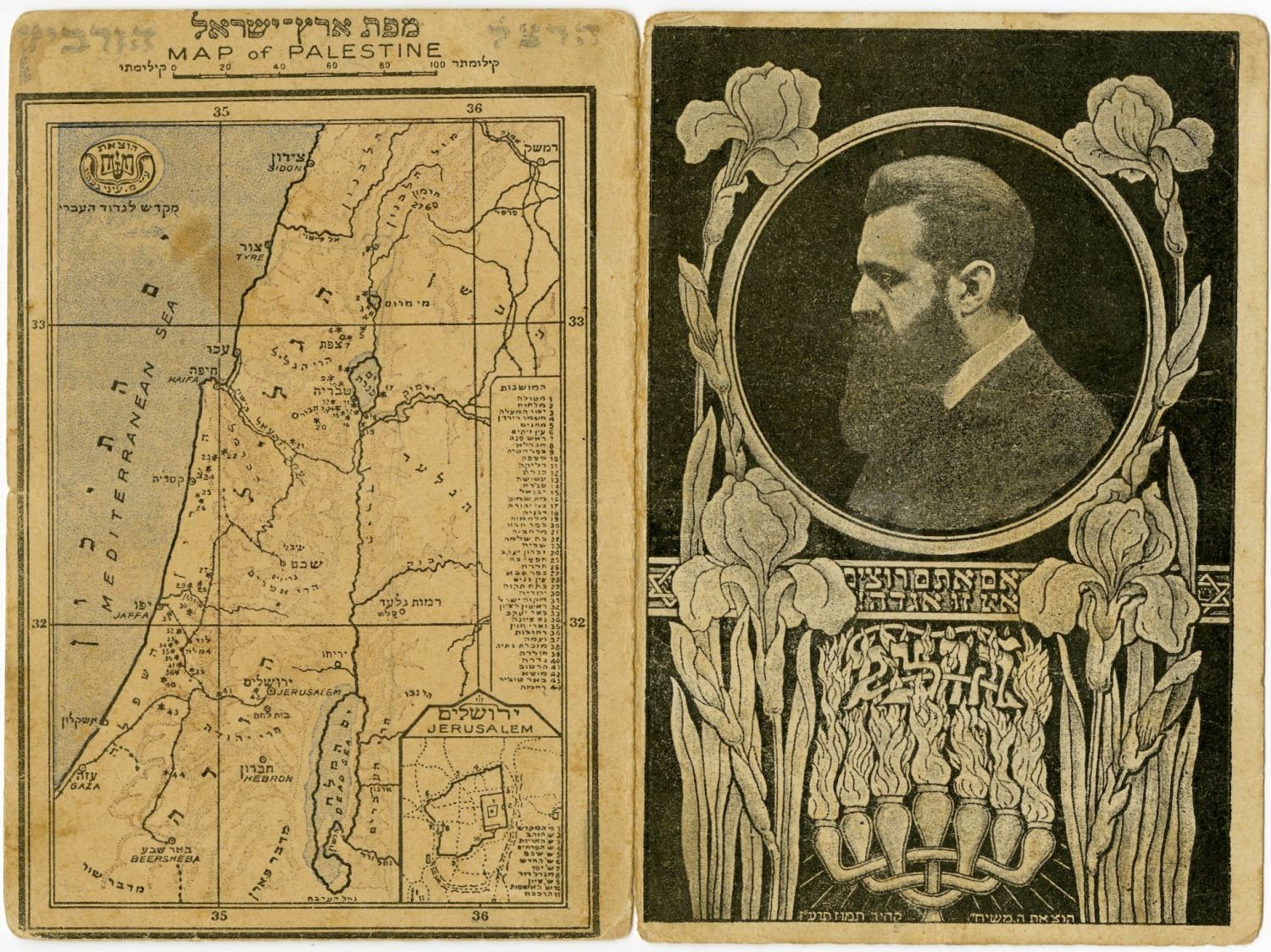
Two postcards originally connected, a portrait of Herzl on the right and a map of Israel on the left. Published by e. "Messiah", Cairo, Tammuz 1917. The design of the postcards was specially designed for the Hebrew Battalion in Egypt.
On the back of the postcard is an illustration of a lion, a Star of David, and a menorah, and the inscription: 'The House of the Hebrew Army, for our people and for our country' (design: M. Eini). Below is the rare emblem of the Mashiach publishing house in Cairo - in the shape of a Star of David combined with a lamp. Sent on June 8, 1919, from the soldier of the Hebrew Battalion 'Shmuel' to his friend Herzl in Jerusalem: '... Hello Herzl! ... There is no very interesting news, but we think we will soon move to Eretz Israel. I am interested to know your situation in Jerusalem ... why is it so bad and bitter your current situation there? ... '(The postcard was sent to Herzl Horowitz - apparently the well-known teacher from the Hebrew school in Rishon Lezion, Who later received Lord Balfour on his visit to the colony. The first lived in Jerusalem, when his mother was deported to Egypt, then the postcard before us was sent to him).
The postcards are reinforced with glue in the connector strip. Stains. Good condition.
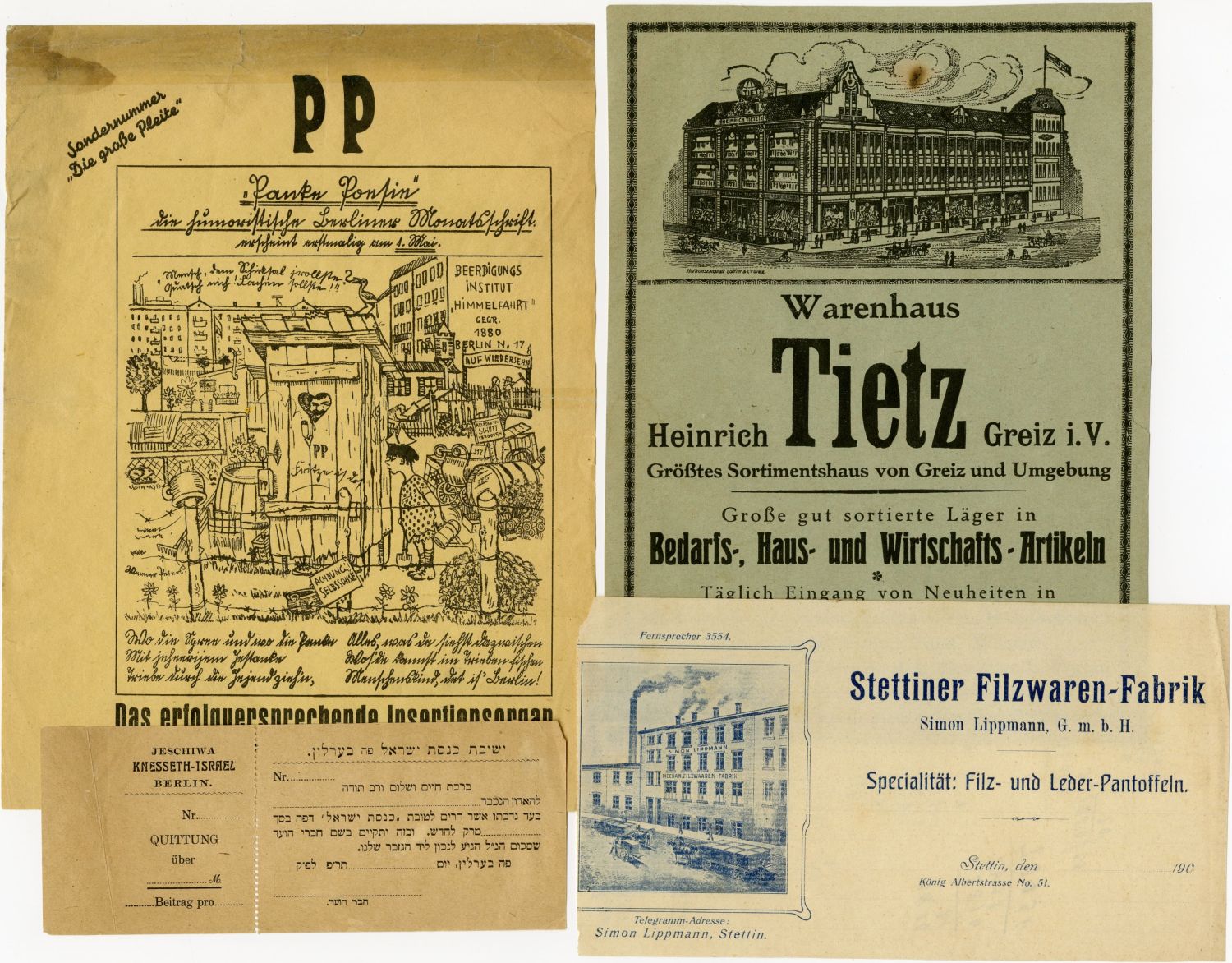
14 advertising leaflets for Jewish factories and store, most of them in Germany. Early 20th century.
Among them: Shimon Lipman's Fabric Factory, G. Boksbaum Krakow, owner of novi bohumin C.S.R. Heinrich Gretz's hotel, and others. Also appear, two early German newspaper pages with advertisements for Jewish businesses, reception of the Knesset Israel yeshiva in Berlin, and more
Various sizes, overall very good condition.
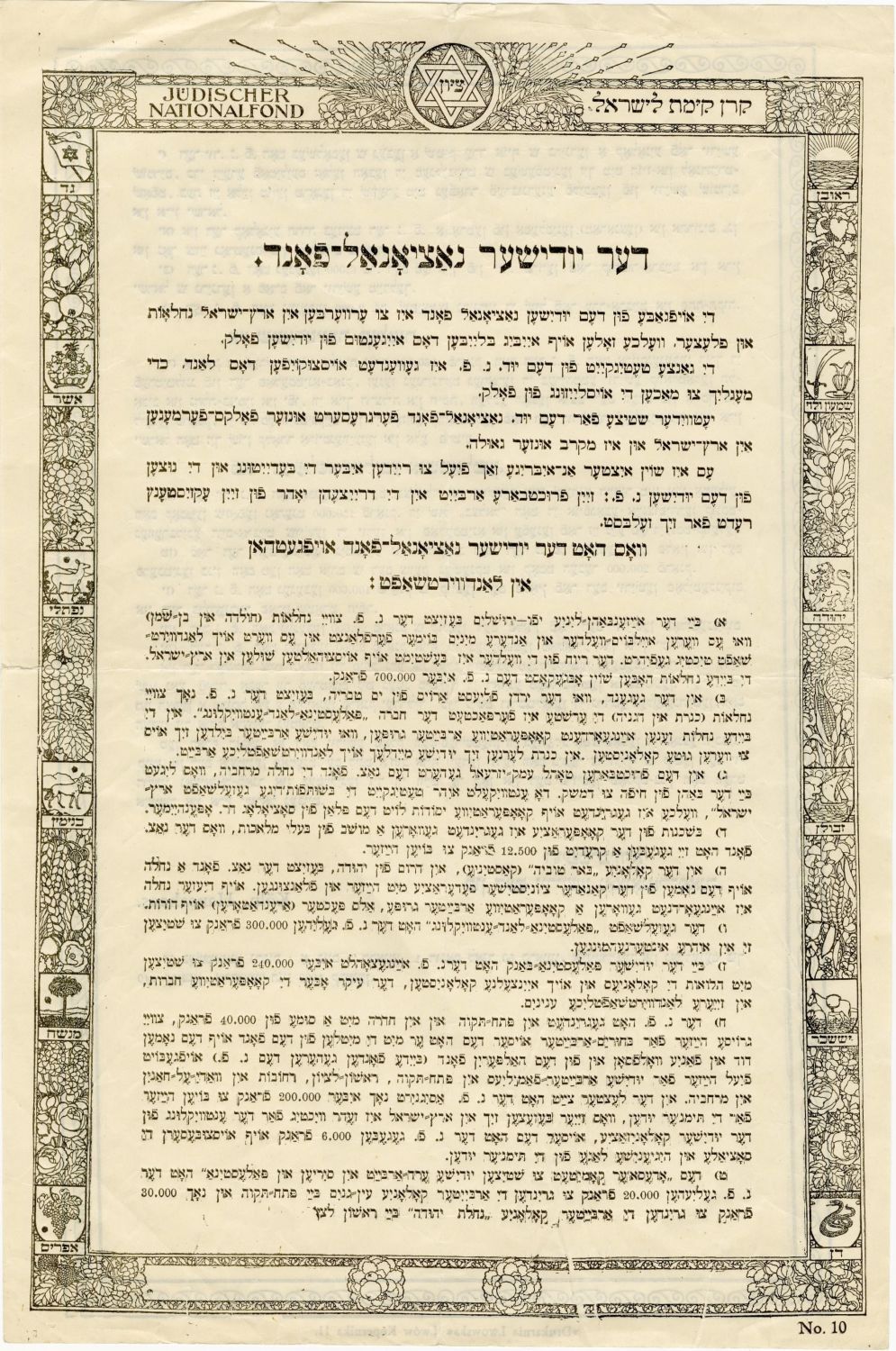
דער יודישער נאציאנאל-פאנד - The Jewish National Fund - A two-sided advertising poster detailing the JNF's large-scale acquisition of land in Israel, calling to the Jewish public to participate in donation for a new opportunity to purchase land. Yiddish, c 1920s, Printed in Poland (Krakow).
At the top of the poster is a Star of David with the caption 'Zion', and around a frame with illustrations of the twelve tribes.
Size: 32x21 cm. Very good condition.
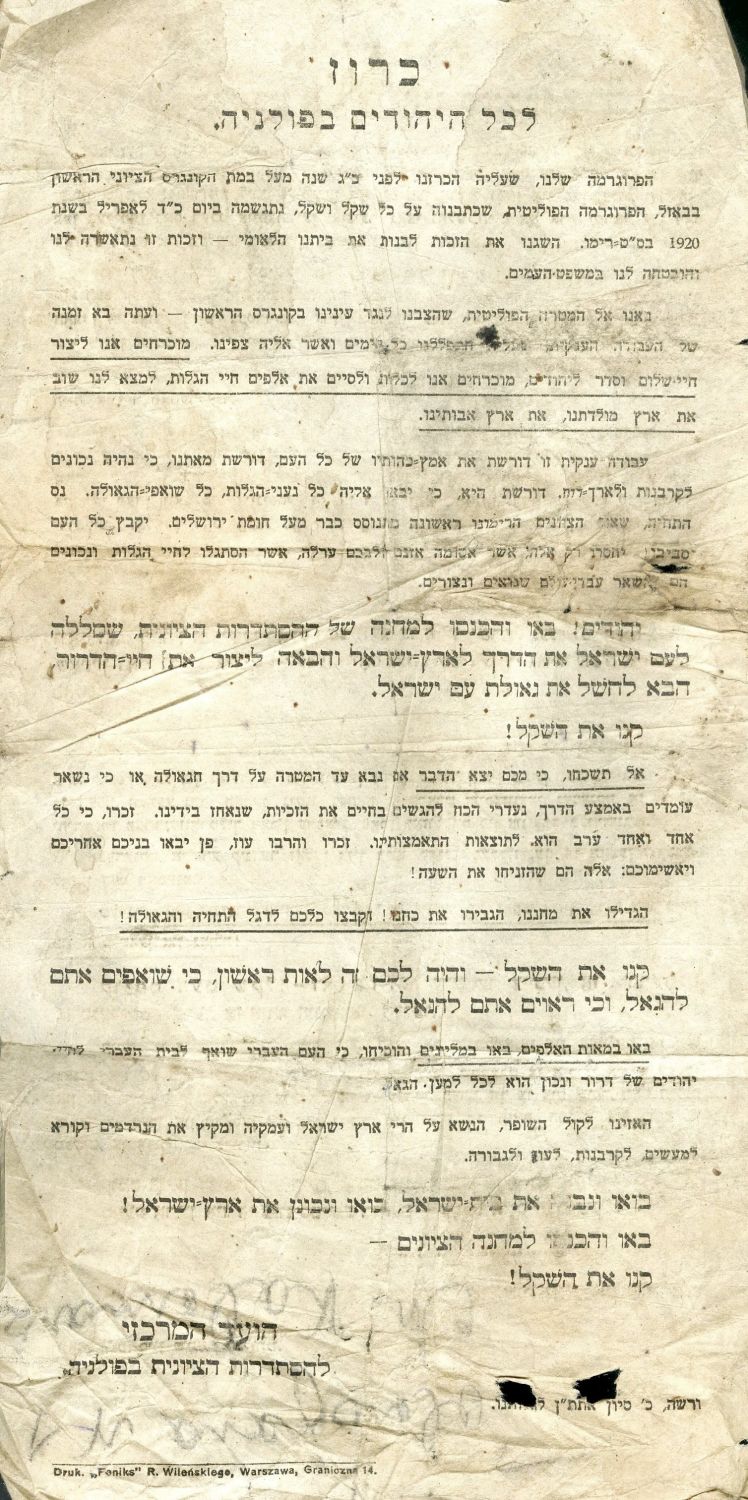
An interesting proclamation circulated in Warsaw calling to all Polish Jews to participate in the NIS donation for the Zionist enterprise. Distributed on behalf of the Central Committee of the Zionist Organization in Poland, Warsaw, 1921. "Fenix" print. Two-sided proclamation - Hebrew and the other side is translated into Yiddish.
"We must create peace and order for the Jews, we must consume and end the two thousand lives of exile, find our country again, our ancestral country ... Jews Come and enter the camp of the Zionist Histadrut, That paved the way for the people of Israel to come to the Land of Israel and to create freedom life to eliminate the redemption of the people of Israel. Buy the shekel!" Later again the proclamation calls to the general public to buy the shekel:" Buy the shekel - and you had the first sign that you want to redeem and that you deserve to be redeemed".
31x15 cm. Wrinkles and stains. Moderate condition.
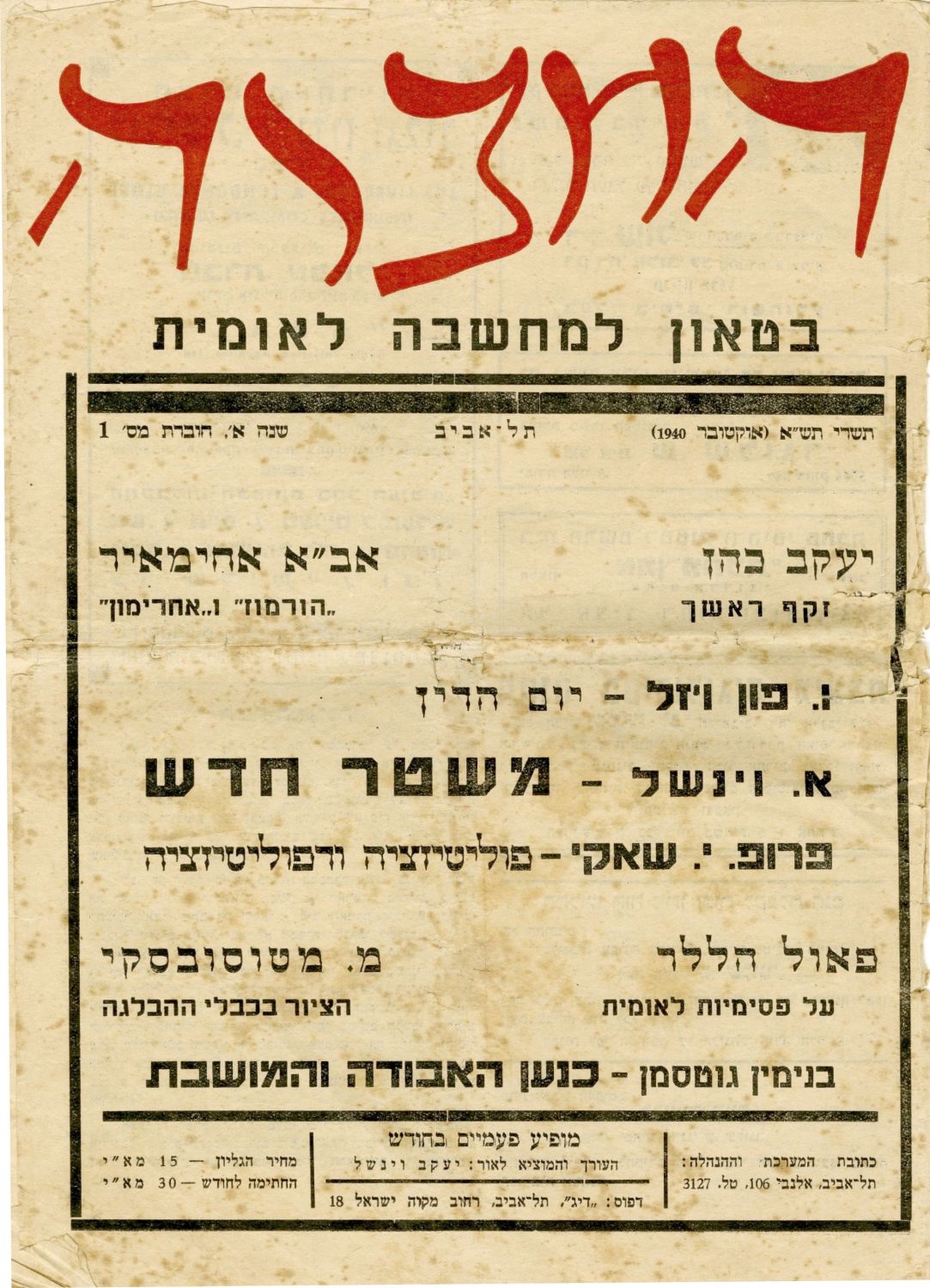
Hachevreh' - An issue of National Thought - First Year - Booklet # 1. Bi-monthly issue of the Revisionist National Movement . October 1940
The first booklet published by Yaakov Winsel and his brother Abraham Winsel, in which the editors thank the letter designers in the spirit of the first Hebrew rebellion: "we expresses gratitude to the painter M. Matosowski and the artist Zvi Bergman for the Art rendering of the engraving to our newspaper, especially for attempts to revive the letters of the First Hebrew Revolt according to the ancient coins of the time, this is the text of the Hebrew writing in recent times for the independence of the Hebrew state."
Stains. Folding sign throughout the booklet. A slight tear on the title page. Good condition.
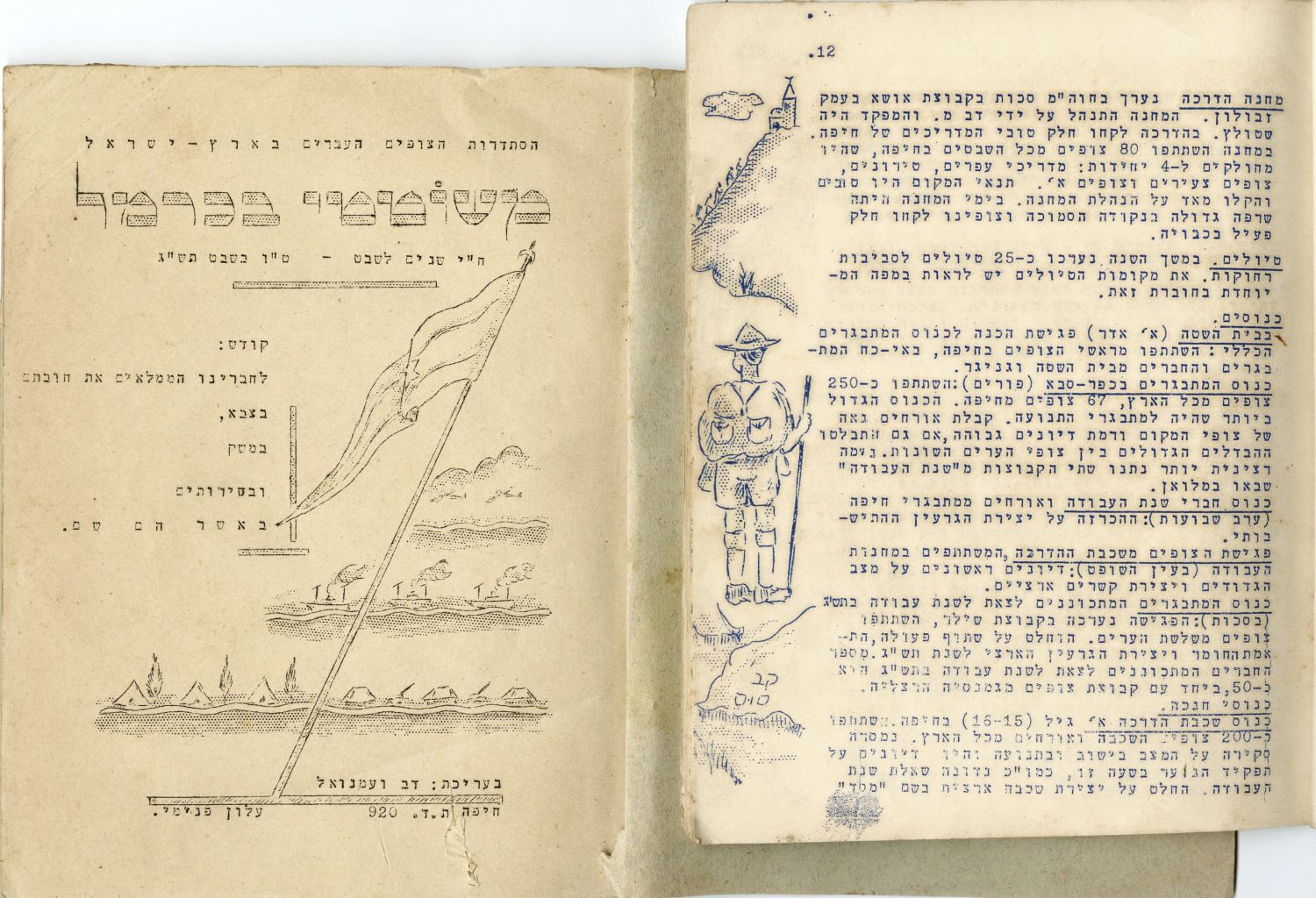
A collection of 22 brochures and leaflets of the Scouts movement from its early years in the Land of Israel. Rare and one-off stencil prints, 'internal' leaflets, small-volume publications, for one tribe and more. Some of the pamphlets and publications before us do not appear in the National Library. 20s to 70s.
* Boy Scouting - An Auxiliary Book for Scouts and Their Commanders By Sir Robert Beden Poell Edited by Dr. A. Tsafroni, Jerusalem 1927.
* Wanderers in Carmel - 18 year to tribe. Haifa Tu B'Shvat 1943. Rare publication in stencil printing.
* The "carve" Page - Stencil Printing, October 1958.
* Be aimed - in the Hebrew Scouts Federation Town in Israel. 1956-1958 - four issues years: 1957-1958 numbers: 34-35, 36-37, 38, 43.
* Scouting games edited by Moshe Zelika and Eli Shlomi - stencil printing.
* Scouting booklet, edited by Moshe Zilke, published by the Jewish Scouts Federation in Israel.
* Three Newsletters for the Guide - Know your movement,
* Purimon - Stencil Printing comic Newspaper, 1966
* notebook for a guide, published by the Jewish Scouts Federation in Israel.
* Redemption singer - 'Redemption' tribe Haifa - Haifa Youth and Pioneer Department 1965. stencil Print.
* Quarry - The Cutters Newsletter - Five sheets of stencil printing.
* Booklet 'Follow' - Scouts of Ramat Gan edited by Ilan Zilka.
* Be aimed - the Jewish Scouts Federation in Israel 'internal'. Issue # 6.
* Summer Camp Newsletter 1975.
* 'Scouting Community' - National Secretariat, Youth and Pioneer Department Press - Stencil Printing.
* Parental contribution card [1941] Histadrut Hebrew Scouts in Israel.
Different sizes and conditions.
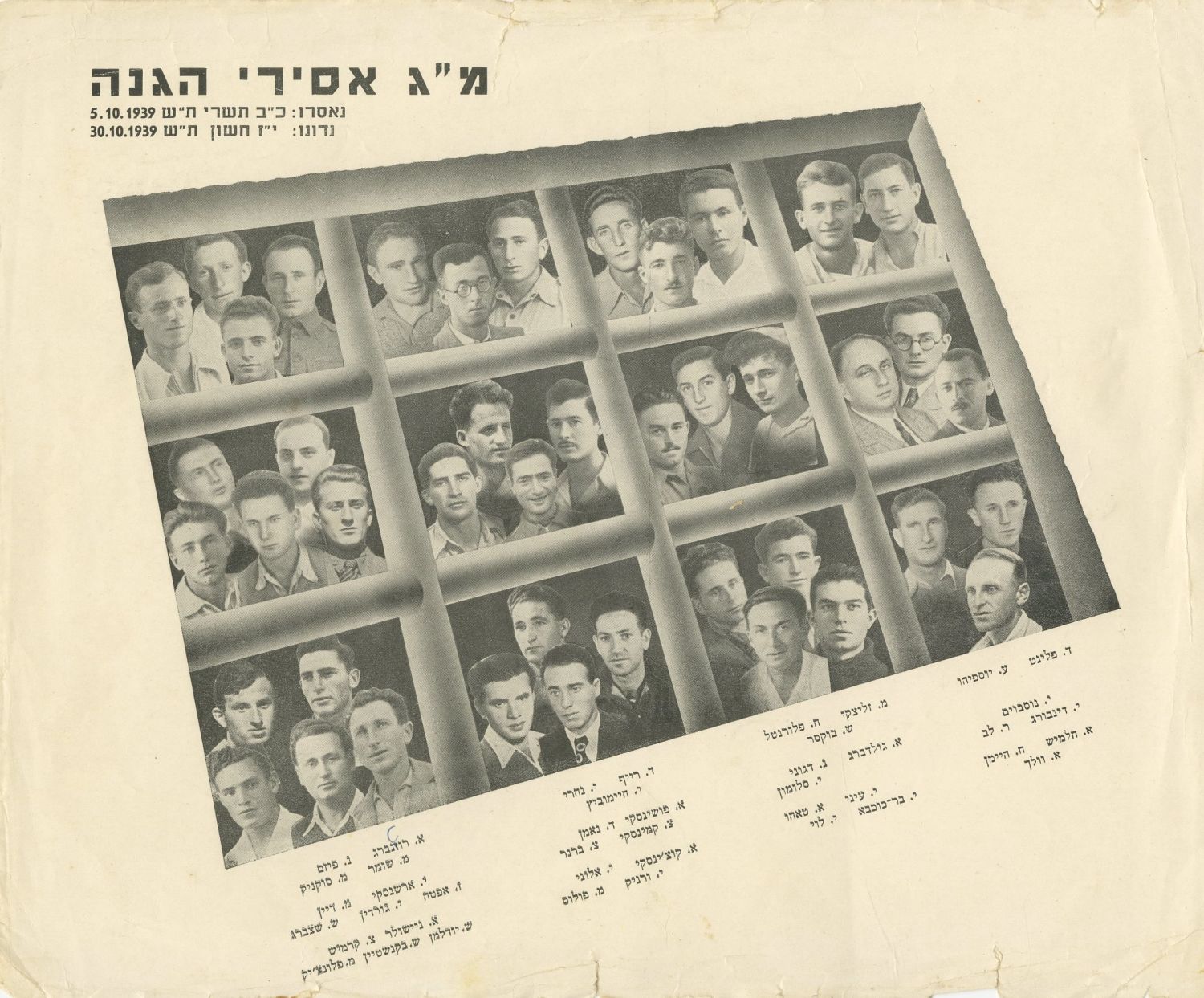
An important poster containing the photographs of the 43 members of the Haganah behind bars, who were arrested and imprisoned by the British Mandate authorities in 1939 in a case that shocked the Jewish community in the land of Israel at the time. (In the middle row on the lef - Moshe Dayan).
During the events of the Great Arab Revolt in 1943, 43 members of the "Haganah" were arrested by the British police on charges of organizing underground espionage. In October 1939, British police officers arrived at a central training course for commanders of the "Hagana" ranks in Yavniel. As part of an attempted escape from the place, 43 members of the Haganah were arrested and taken to Acre Prison where they were interrogated and beaten. The verdict was given on October 30, 1939. Avsalom Tao was sentenced to life in prison, and his friends - to ten years in prison. During the entire prison term, the community leaders did not stop working for their release. On February 22, 1940, they were transferred from the Acre prison to the detention camp north of Acre, which was an open place and the conditions were better. With the improvement in relations with the British, and in view of the approaching front in World War II to Eretz Israel, all were released on February 17, 1941. Among the members of the "MG" were Moshe Dayan and Moshe Carmel, who even wrote a book on his imprisonment.
rare. The poster does not appear in the ephemera collection at the National Library.
Size: 25x21 cm. Slight tears on edges. Good condition.
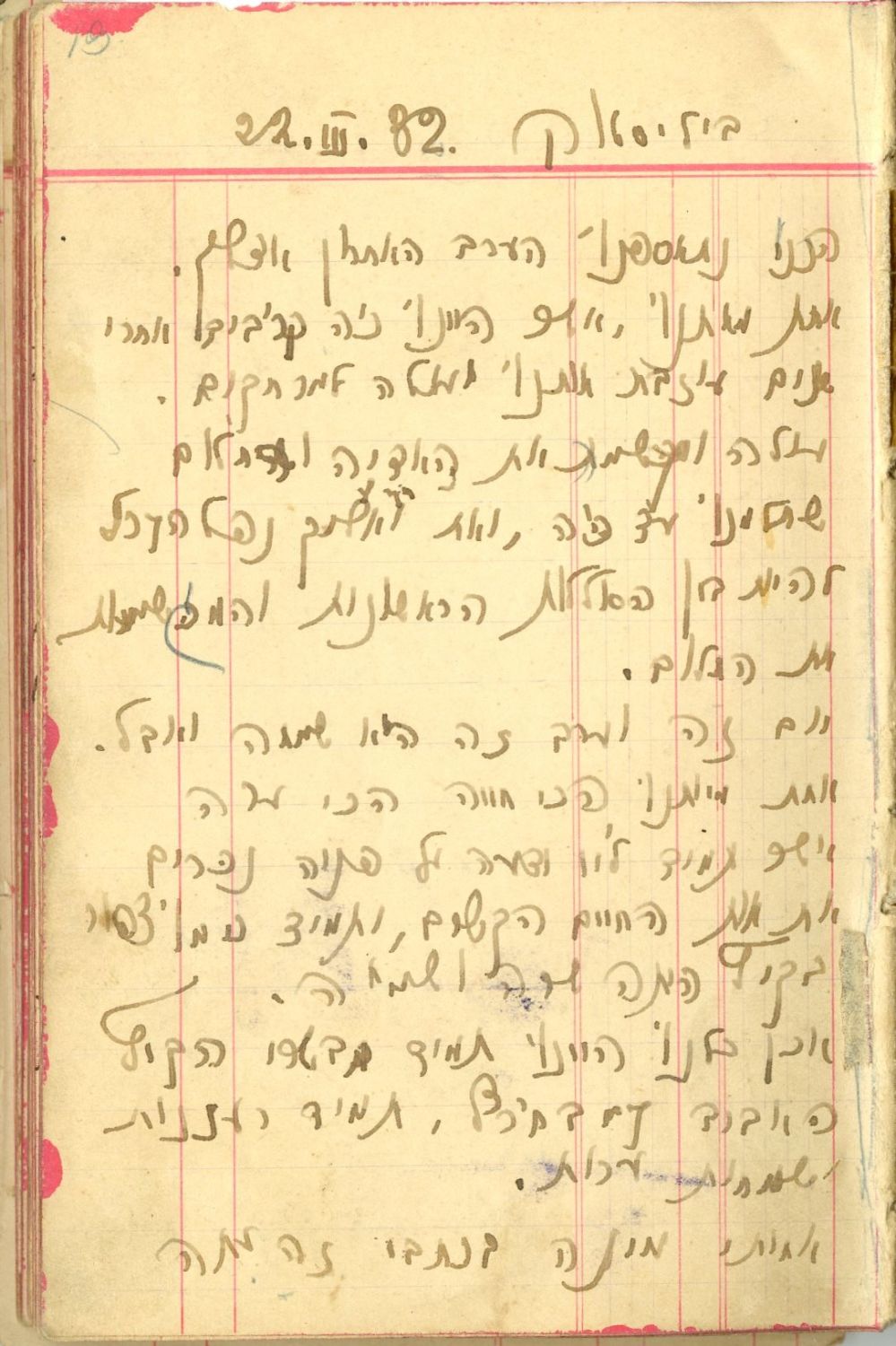
An exciting diary written on a personal and candid way containing a vivid description of a girl's journey called "Mina", from Bialstock through Warsaw to Eretz Israel, and the pioneering life in Eretz Israel. Bialstock - Eretz Israel, 1932.
The diary opens on the last festive evening made by Mina's friends on her departure from Bilastok to palestine: "Bialstock 3/22/32 We were gathered this evening with you, one of us, who we were so close. after years leaving us and going far and fulfilling the idea and dream we had dreamed, and you, who in your part was destined to be one of the first and fulfill the dream ... ". The first page writer in the journal - Mina's friend asks her to fulfill all the values they believed in the Land of Israel: "Your social obligations to the movement you incomplete in exile, but in exile this is the beginning, In the Land is the End ... Do not assimilate in the land among the simple girls, who will never find your place ... We have a future ... You have the moral debt ... Go on ... "
Going forward is a description of Mina's journey through Warsaw and other cities to Palestine. These pages are written by Mina in Yiddish. After Mina arrived in Israel she moved to write the diary in Hebrew. Among other things, she describes a first visit to Rachel's Tomb in Bethlehem "I asked our Holy Mother to have mercy on my parents and send them a blessing medicine for livelihood and mercy ...". She also describes her first visit to Jerusalem in Yad Avshelom, in Hizekiah's Cave, in the tomb of Shimon Ha-Tzaddik, and in other places, as well as on her meeting with her friends She knew in Bilostok and Warsaw, and in other places: 'There were ... interesting guys ... everyone From Russia ... people who have done meaningful things in their lives ... I met the Polish - the "boxers" from Poland ... ". She describes her attempts to find work as a "pioneer", until she finally reached the "working economy" in Petah Tikva, and worked in the garden. She also talks about her visit to the Government Museum, about playing football between "Hapoel" and the British police she watched, about the competition between "Hapoel" and Egyptian representation, about her first visit to the "Habima" theater, the Cinema "Zion", and more. On one of the pages, Mina describes the 'Bikurim' holiday in Eretz Yisrael. And there are personal descriptions documenting her friendly relationship with her friends.
67 Written pages. 16 cm. original Fabric covered cardboard binding. Stains. Good condition.
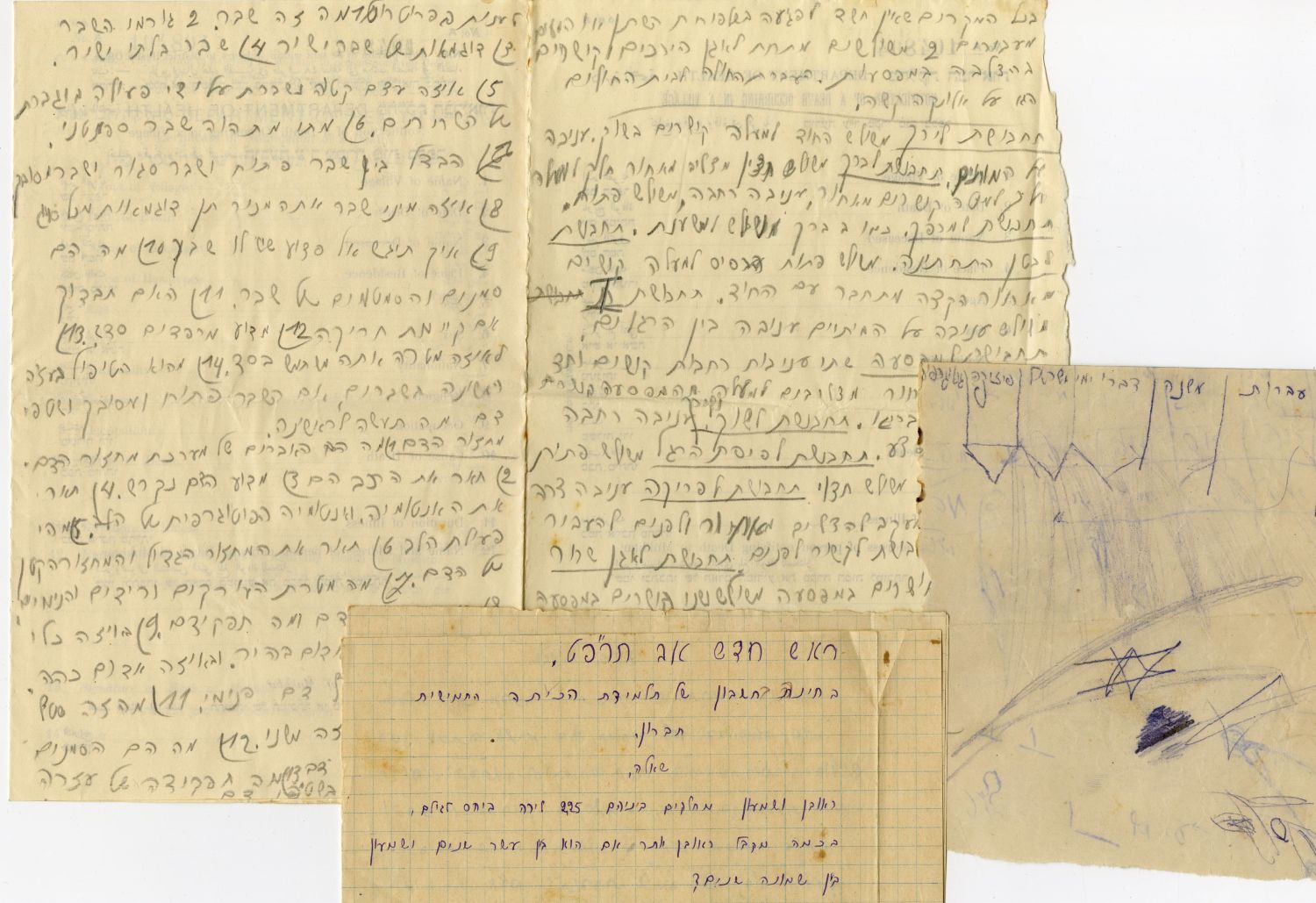
"Fracture Symptoms, Twin Beams, Bone Squeaking at the Time of the Accident, Pain, Failure to move ... Do not move the injured person without fixing the limb, except if there is a Life-threatening ... Unconscious injury is suspected of spinal fracture ... if The injured is complaining of pain in the neck and is consciously having to pass on a hard stretcher ... '. These training chapters for the treatment wounded written on the pages of a student notebook by Esther Brickman no less than new moon of av month in Hebron! Only two weeks before the outbreak of 1929.
Before us, pages of a fifth-grade student, Esther Brickman of Hebron, Dealing with the treatment of the injured, and in providing first aid for the injured. The comments were written on official pages of the Health Department regarding "Notification of deaths in the village" or "Notices of birth in the village". The date on which they are written is "Rosh Hodesh Av 1929, Hebron" About two weeks before the outbreak of the events in the city that claimed the lives of 133 Jews, and 339 were injured. A total of 13 pages appear in Brickman's handwriting dealing with the wounded, the rest dealing with Arithmetic exercises, grades she received, and a letter to a fraind ["How much I miss you I can't spend the eight days off from school, I don't know what to do ... I really want to come to you but I have no money .... '].
[27] leaves, general condition good.
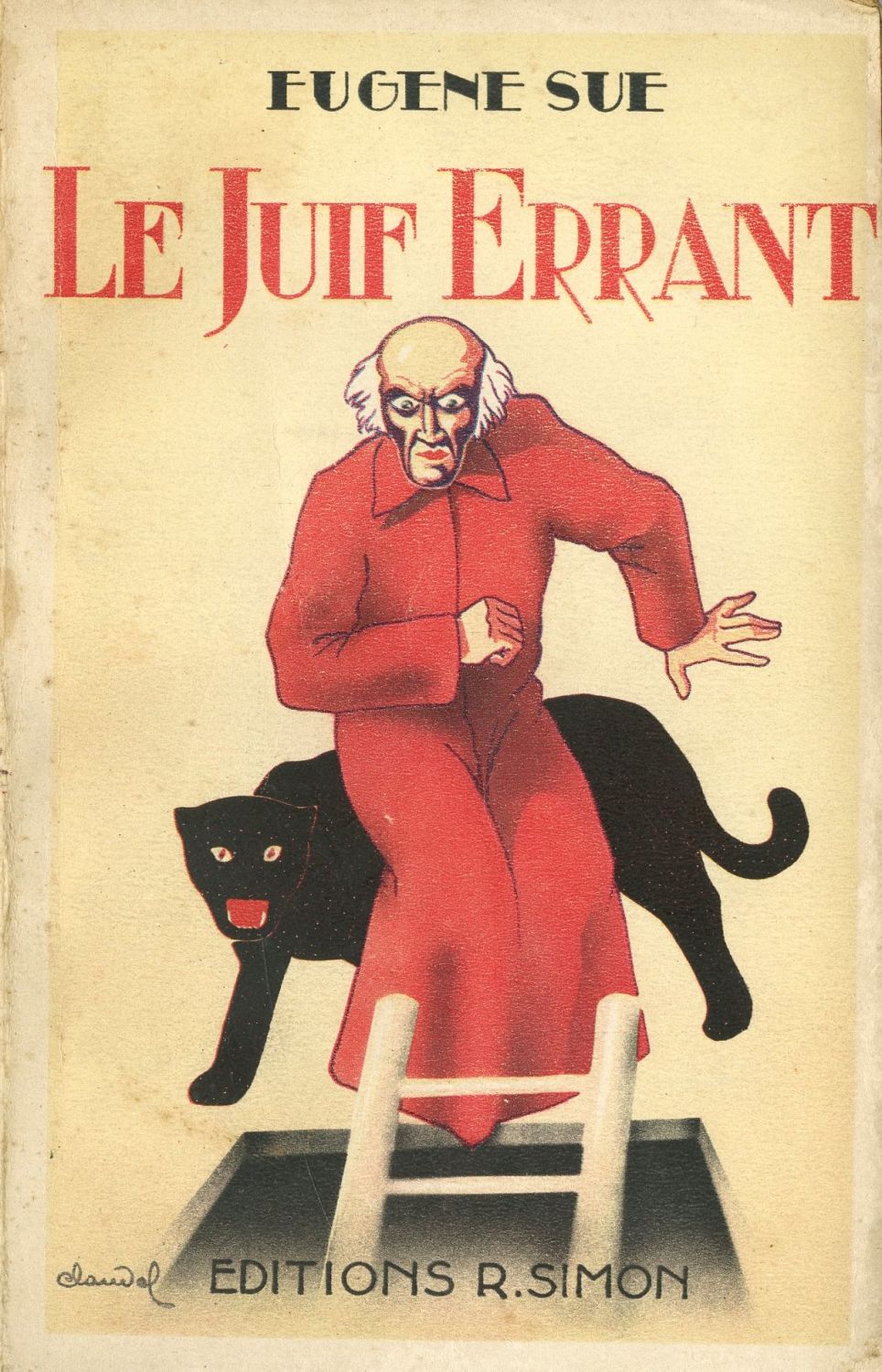
LE JUIF ERRANT Three sequels plot books for teenagers on the subject of 'The Wandering Jew' by Eugene Sue, France, early 20th century.
Eugene Sue [1804-1857], nicknamed the French writer Marie-Joseph Sue, the founder of the 'simple literature' and the founder of the sequel novel, who became known as the "King of the Popular Novel", because he was the most read writer of his time in French fiction. From 1844 to 1845, Sue published his ten-volume book "The Wandering Jew" (Le Juif errant). In this story there is a struggle between the forces of justice against the forces of black. In the book, Sue presents all the distortions of society, from the lower class whose rights are trampled on by the corrupt government to the The disadvantaged women. This book describes more cruelty than the stories he has written in the past, and he uses horror to convey his messages, while sowing fear and shudder his readers. "The Wandering Jew" was published in a sequel in the 'le Constitutionnel' newspaper. In return for the story, the newspaper offered him 100,000 francs, a huge sum in those days, but the newspaper's profits improved miraculously in view of the newspaper's circulation which rose from 6,000 copies a day to 25,000 in a short time.
Two of the books published by R. SIMON Paris, and one book published by LES BELLES EDITIONS, Paris. general condition Good .
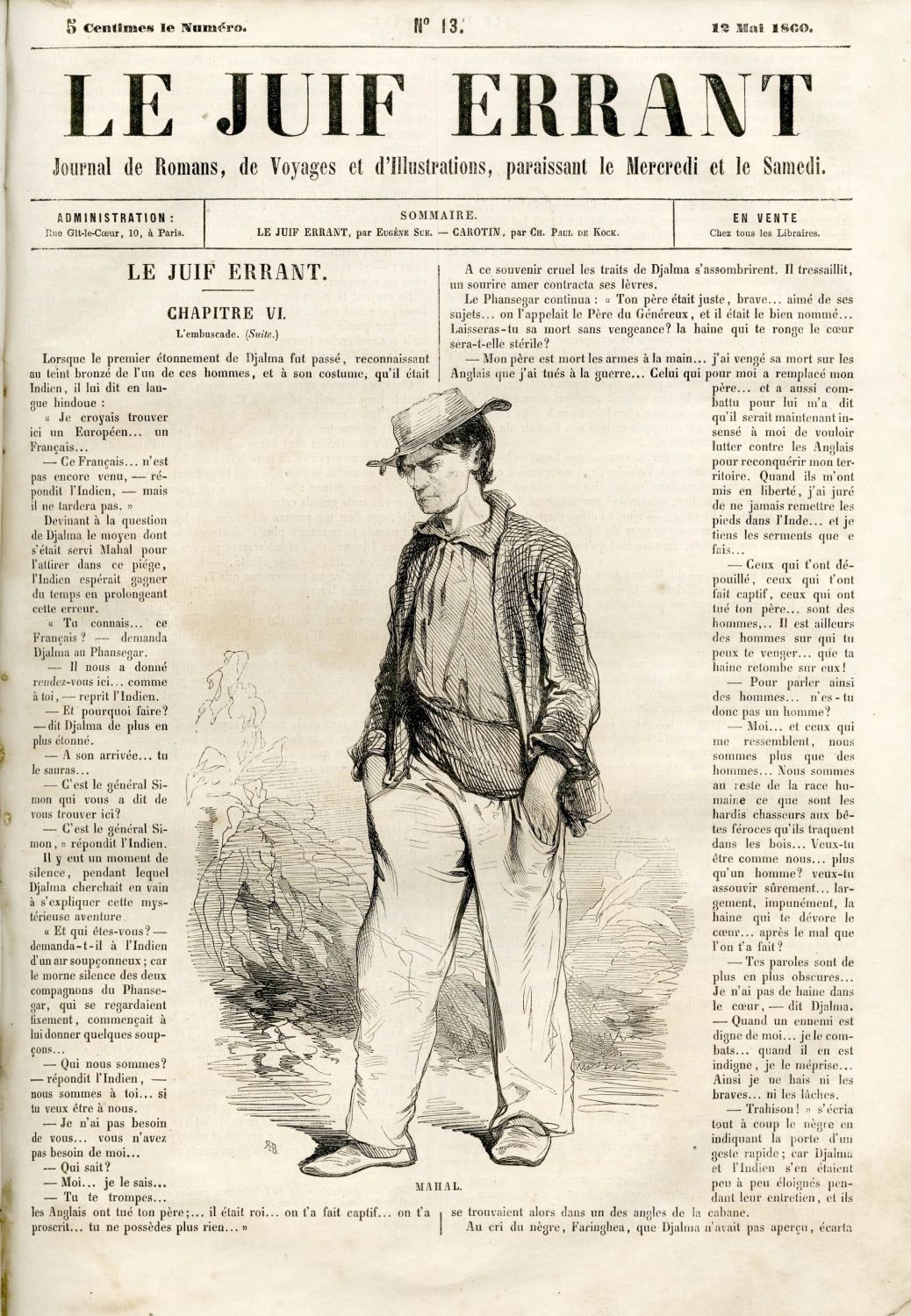
LE JUIF ERRANT Journal of the Romans, Voyages and Illustrations, Paraissant le Mercredi et Samedi - The Wandering Jew - a Serialized magazine on the 'Wandering Jew'. One hundred consecutive issues published over the course of a full year: 1-101. Paris, from March 31, 1860 - March 16, 1861. From the early publications published continuously on the subject of "The Wandering Jew" in France.
At the cover of each sheet is a painting of the wandering Jewish figure, and an antisemitic plot story usually in the medieval atmosphere.
The legend of the wandering Jew is based on The Middle Ages anti-Semitic folk tale about the Jew who, because he lost his death, could not lose his life, and therefore occasionally appears in different forms and plays different roles. The legend originated in 1228 in a story about a Christian priest who met a Jew (And according to one version Jesus himself who met a Jewish shoemaker on the way to his death), and it served as an object of various anti-Semitic stories about the Jews that appeared in caricatures mainly in nineteenth-century France, portraying the wandering Jew as a foreign threat to human society.
416, 416 p. 100 consecutive sheets. 32 cm. Few stains. Original cover with gilt on spine. Loose spine. Stains. Good condition.

Emil Zola, a handwritten letter and signature. Signed: "Z". The letter was written during Zola's stay in London, where he fled when he was sentenced to imprisonment following the publication of his article "I Blame" (J'accuse) in defense of Alfred Dreyfus. [London], October 1898. French.
In his letter sent to "Dear Fellows" without mentioning his name, Zola's predicament was reflected during his exile to London. He writes to a friend that if he passes 30 liber (The period coin) to other friend he will remain completely without money, so he prefers to give a check instead through a person named Violet. He also seeks to rent a bicycle for 30 shillings a month, and writes that four libers are supposed to be enough for his needs for three months, asking for additional financial help, and signing: "I will remain grateful that you have come to my aid in one of the most difficult circumstances of my life."
French writer and publicist Emil Zola (1840-1902), from the major supporter of Alfred Dreyfus who was accused of betrayal of the homeland and espionage in favor of Germany. In 1898, Zola joined in fighting the war of the Jewish officer. Zola has initiated actions to prove Dreyfus's innocence following the material he collected on the subject of Jewish writer Bernard Lazar. In a series of articles, Zola proved Dreyfus to be innocent. In January 1898, in the L'aurore newspaper, he published the article "I Accuse" (J'accuse) - an open letter to the President of France, accusing the army chiefs, the War Office and the military tribunal in distortion of law. About 300,000 copies of the paper were hijacked within hours, and the article shook the French public. Zola was prosecuted for libel, sentenced to a year in prison and forced to flee to England. He stayed in London for about a year. In London he lived a mysterious life, under pseudonyms (so he did not sign his full name on the letter before us), until he learned of a retrial for Dreyfus. In June, 1899, and was allowed to return to Paris.
Translation of the letter into Hebrew, and French transcription will be sent By request.
[3] Written pages, 18 cm. Very good condition.
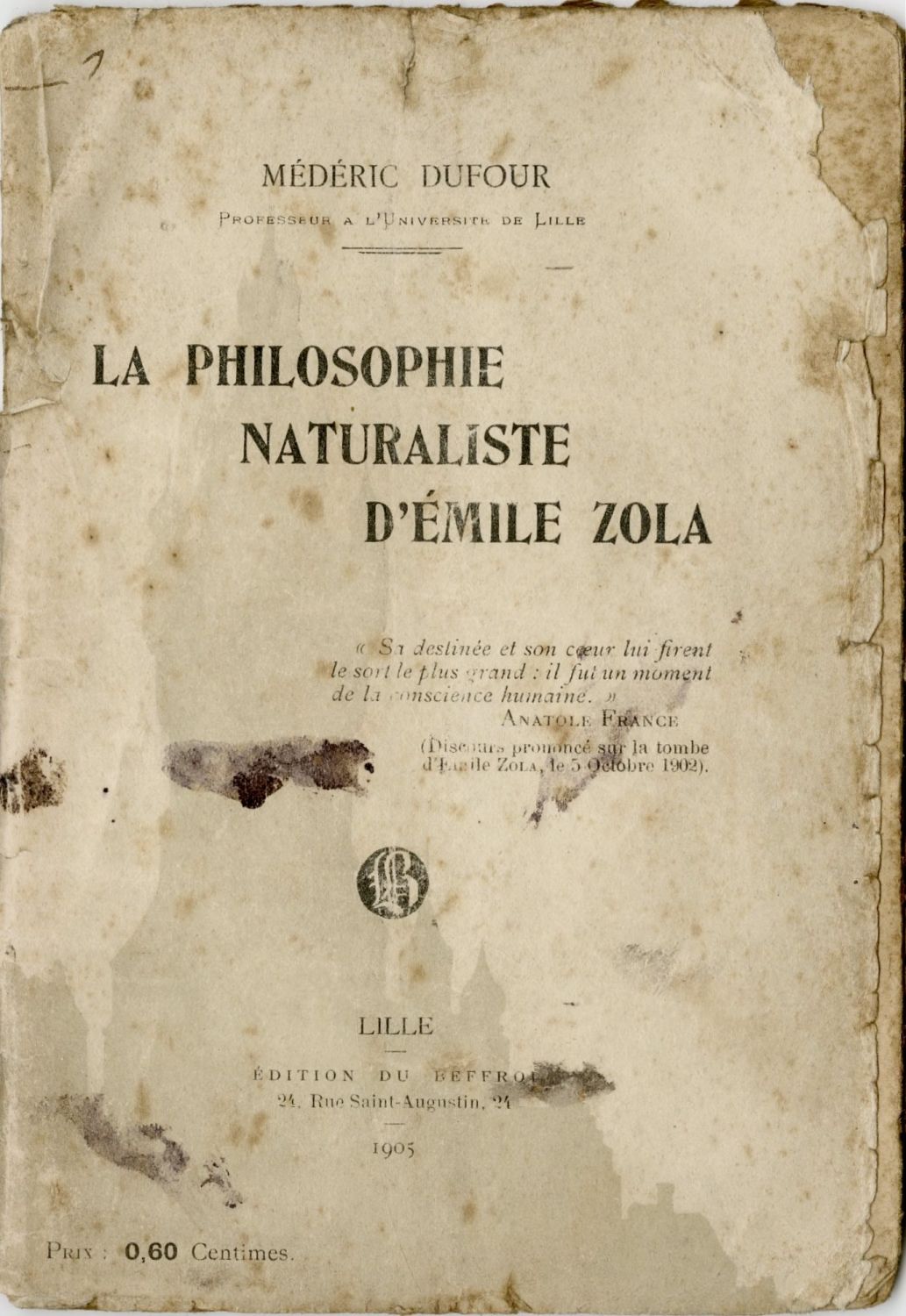
La philosophie naturaliste Emile Zola - The Material Philosophy of Emile Zola by Mederic Dufour, Lille [France], 1905. First edition.
An early essay dealing with Emil Zola's naturalistic approach while exploring his complex personality. First and rare edition, does not appear in the National Library. Only three copies list on OCLC catalog in French libraries.
50 p. Stains. Tears at the edges of the title page and on the back cover. moderate - good condition -
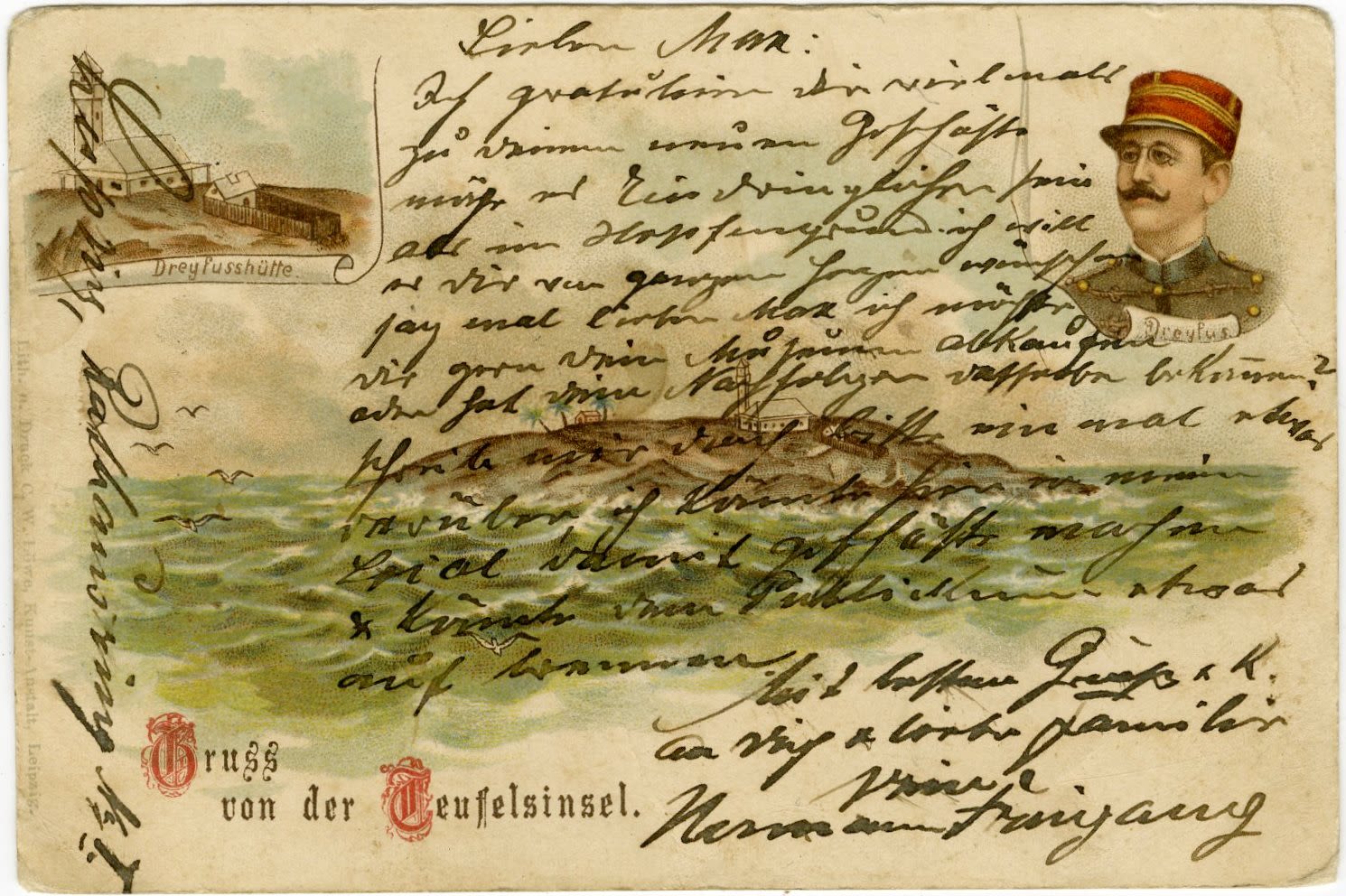
Gruss von der Teufelsinsel - "Blessings from Devil's Island". An early [undivided back] antisemitic postcard issued while Dreyfus was deported to the devil's Island. Lithographic print. Sent by mail in 1898.
To the left is the hut in which Dreyfus was held, to the right the figure of Dreyfus, in the center, the Devil's Island. A German publishing house mocking Dreyfus, who is rotting in prison.
After being sentenced to life in prison in his first trial, Dreyfus was sent to Devil's Island. He was placed in a 4 by 4 meter hut, his movement was restricted and four guards watched over him day and night. The temperature on the island reached 45 degrees, and he was given nutritious military rations. While there, Dreyfus contracted several tropical diseases, and received poor treatment. His health condition worsened from year to year. He could write to his wife, but letters from her rarely reached him, he was utterly despairing, Convinced of himself, like many in Europe of those days, that his life would end on the island of demons.
Devil's Island - off the coast of South America, is famous for the secluded prison that operated in it which is one of the most famous prisons in history. The island, as part of the Salvation Islands, served France from 1852 to 1946, and contained a variety of prisoners, from political prisoners to thieves and murderers. More than 80,000 prisoners were sent to a place characterized by harsh living conditions and disease. The atrocities and harsh conditions in which the prisoners were held at the place came to the public consciousness in 1895 with the publication of the imprisonment of Alfred Dreyfus who was sent to prison on the island.
Undivided Back, very good condition.
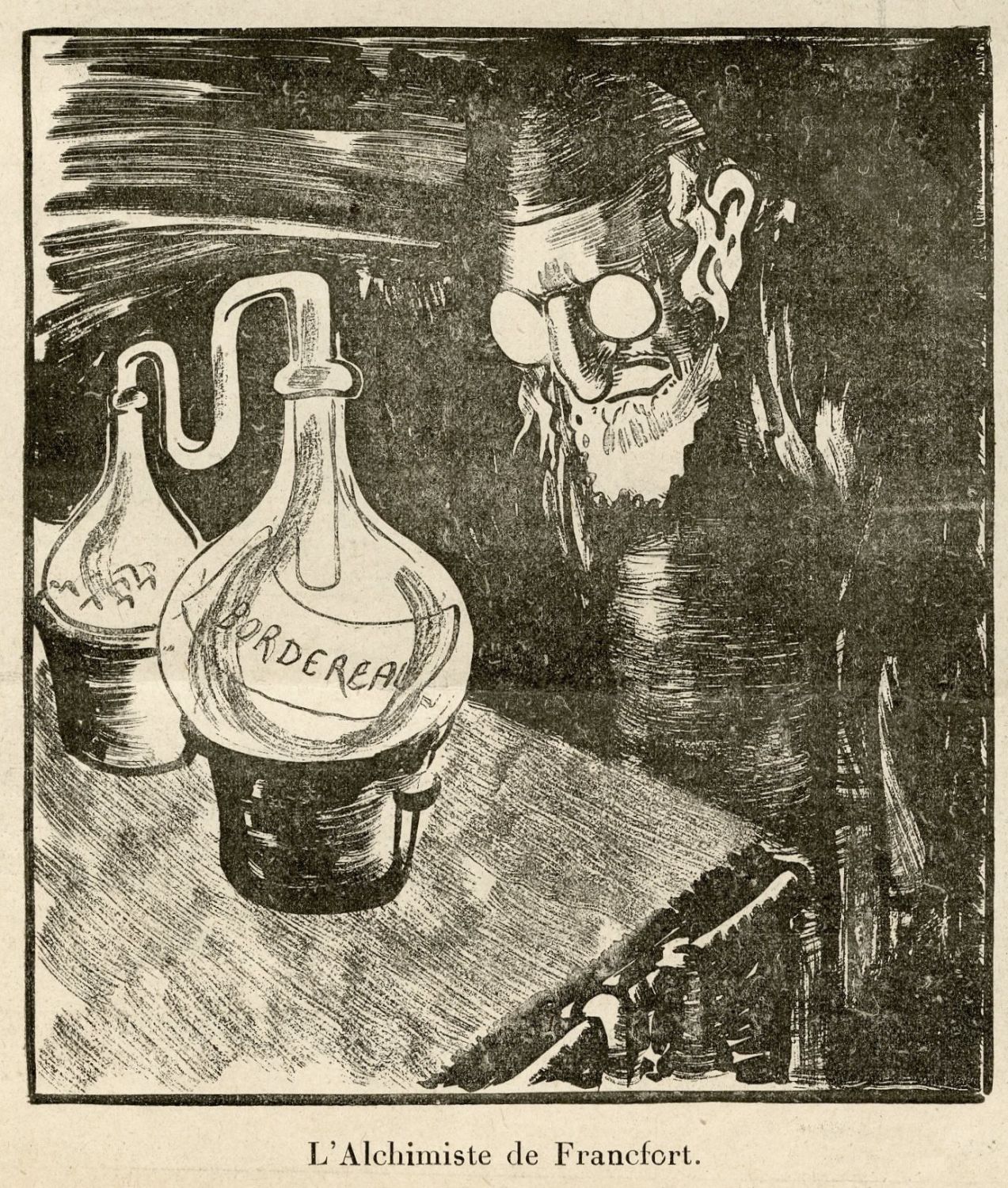
Three issues of the antisemitic and anti-Dreyfus weekly "Psst ...!". Paris, 1898.
* Issue dated April 2, 1898, a large cartoon in which a Jew is seen returning home. His wife asks: "Well, how was the party? And He replies:" Lovely! No one dared to talk to me about the Treyfus affair - "dreyfus" - "stereotypical Yiddish steering [see the Dreyfus affair and its reflection in literature, art and media edited by Norman Clevelat, p. 56].
* In an issue dated May 14, 1898, two Jews speak on the streets of a city under torrential rain: Drumont is chosen! We're losing Algeria, uh ... zola is costing us dearly! .
* Issue dated July 30, 1898 describes the 'Road to the Fortress' lined with Jews ....
Psst ...!, An illustrated magazine founded by Jean-Louis Forain and Caran d'Ach (pen name of Emmanuel Poiré).
A French weekly that regularly published antisemitic cartoons during the Dreyfus trial. Released in a regular four-page format full of venomous antisemitic cartoons by Jean-Louis Forain and Caran d'Ach, which appeared regularly during the affair.
Three sheets. Very good condition.
Created and Develop with 🤍By webe ©2024